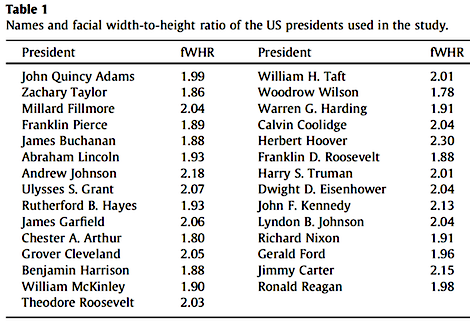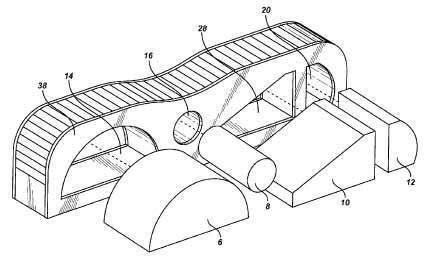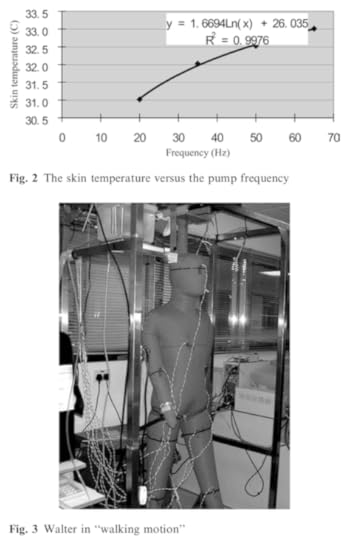Marc Abrahams's Blog, page 591
February 29, 2012
A look at Walter, the sweating manikin
This image shows Walter, the sweating manikin, whose wholesome story is told in the study "New Functions and Applications of Walter, the Sweating Fabric Manikin":
For more detail and context, see this week's Improbable Research column in the Guardian.

Fish farts, Russian submarines, the Swedish Foreign Minister
 Maggie Koerth-Baker of Boing-Boing interviewed several journalists at the AAAS Annual Meeting last week in Vancouver, about what they had learned at the meeting. Here's me, blabbing on about a new little chapter in the story of how fish farts almost caused a diplomatic crisis between Russia and Sweden, and might cause a new little kerfuffle in Sweden.
Maggie Koerth-Baker of Boing-Boing interviewed several journalists at the AAAS Annual Meeting last week in Vancouver, about what they had learned at the meeting. Here's me, blabbing on about a new little chapter in the story of how fish farts almost caused a diplomatic crisis between Russia and Sweden, and might cause a new little kerfuffle in Sweden.
The Swedish scientists who identified the herring farts (from Stockholm harbor hydrophone recordings given them by the Swedish government) were awarded the 2004 Ig Nobel Prize in biology. Those Swedish scientists shared the prize with a team from Canada and Scotland who independently made a similar discovery about herring farts. The new (to me) part is the continuing insistence of Sweden's then-Prime Minister (and current Minister for Foreign Affairs) Carl Bildt [pictured here] that the scientists were wrong—that the herring farts were not herring farts, but were Russian submarines sneaking around in Stockholm harbor.
BONUS: On Saturday, March 24, Magnus Wahlberg and Håkan Westerberg, the two Swedish marine scientists, and I, and Magnus ("Chickens Prefer Beautiful Humans) Enquist, another Swedish Ig Nobel Prize winner, will do a public talk in Stockholm. If you are in or near Stockholm, please join us.

February 28, 2012
Yodeling of the Indiana Swiss Amish
Chad Thompson (Associate Professor of Linguistics, Department of English and Linguistics, Indiana University-Purdue University at Fort Wayne, US) is one of the very, very few academic researchers to have written on the subject of Yodeling of the Indiana Swiss Amish. His paper 'Yodeling of the Indiana Swiss Amish' (published in Anthropological Linguistics,Vol. 38, No. 3, Fall, 1996) was written as a result of field observations conducted between 1993 and 1995.
"For religious reasons, however, they [the yodelling Amish] did not wish to be tape recorded or photographed, and in all cases their desires were respected; no sound recordings were made of interviews or yodelling."
And, to date, online audiovisual resources regarding Yodeling of the Indiana Swiss Amish are scarce, but Improbable has tracked down one video which claims to show a resolutely non-camera-shy 90 year old Swiss Amish yodelling exponent in action . . .

Professor Clancy on lime juice
In the further further vaginal pH adventures of Kate Clancy, Professor Clancy goes where few men dare to go:
Vaginal pH Redux: Broader Perspectives on Douching, Race… and Lime Juice

Four Ig Nobel winners coming to Leeds on 8 March
 The Ig Nobel show—featuring a full gaggle of Ig Nobel Prize winners—is coming to Leeds for the first time ever, as the kickoff event in the Ig Nobel Tour of the UK, part of National Science & Engineering Week. The Ig winners have each been honored for doing something that makes people laugh, then think. They each will explain, to the extent possible, what they did and why they did it.
The Ig Nobel show—featuring a full gaggle of Ig Nobel Prize winners—is coming to Leeds for the first time ever, as the kickoff event in the Ig Nobel Tour of the UK, part of National Science & Engineering Week. The Ig winners have each been honored for doing something that makes people laugh, then think. They each will explain, to the extent possible, what they did and why they did it.
When: Thursday, 8 March, 2012, 6:00 pm
Where: Leeds Festival of Science, University of Leeds, Conference Auditorium 1
Featuring:
Marc Abrahams , organizer of the Ig Nobel Prizes, editor of the Annals of Improbable Research , and Guardian columnist
Claire Rind (Ig Nobel Prize winner—for measuring locust brain activity whilst watching Star Wars)
David Gadian (Ig Nobel Prize winner—for measuring the difference between London taxi drivers' brains and those of passengers)
Charles Spence (Ig Nobel Prize winner—forelectronically modifying the sound of carefully bitten potato crisps)
Piers Barnes (Ig Nobel Prize winner—for the maths of taking photos in which no one is blinking)
John Hoyland (New Scientist's Feedback editor, who will reveal the year's best discoveries)
TICKETS are available now

February 27, 2012
Experiments with inflatable & other life-size dolls
 A generic life-size doll, with no modifications, was the key element in at least one unplanned experiment — the experiment documented in a 1993 monograph called Transmission of Gonorrhoea Through an Inflatable Doll, published in the journal Genitourinary Medicine. But generally, scientists who conduct planned experiments that rely on life-size dolls prefer to carefully optimise, or even create, their own doll.
A generic life-size doll, with no modifications, was the key element in at least one unplanned experiment — the experiment documented in a 1993 monograph called Transmission of Gonorrhoea Through an Inflatable Doll, published in the journal Genitourinary Medicine. But generally, scientists who conduct planned experiments that rely on life-size dolls prefer to carefully optimise, or even create, their own doll.
That unplanned inflatable doll experiment centred on a ship's captain who "with some hesitation … told the story" while being treated at a sexual disease clinic in Greenland. The captain had without permission entered an absent crewman's cabin, borrowed a piece of equipment, and later suffered the consequences.
 That inflatable doll was not purpose-built for scientific use. Only through delightful happenstance did it satisfy the scientists', as well as the captain's, needs. Most scientists hate to depend on serendipity, especially if they have to depend on a doll.
That inflatable doll was not purpose-built for scientific use. Only through delightful happenstance did it satisfy the scientists', as well as the captain's, needs. Most scientists hate to depend on serendipity, especially if they have to depend on a doll.
A new study called Convective Heat Transfer From a Nude Body Under Calm Conditions: Assessment of the Effects of Walking With a Thermal Manikin [mannequin] exhibits the forethought and niggling care that can go into acquiring a suitable nude doll….
So begins this week's Improbable Research column in The Guardian.
BONUS [shown in photos accompanying this blog item]: Two modern inflatable dolls, one called "Judy", the other called "Big Mouth Toys Inflatable John". The versions pictured here are off-the-shelf models, not intended exclusively for scientific experimentation.

Presidents' Face Shapes and Achievements
The shape of American presidents faces tells much about how they would and did act, suggests a new study (which cites a recent similar study about corporate CEOs' face shapes and their companies' performance):
"Facial width-to-height ratio predicts achievement drive in US presidents," G.J. Lewis, C.E. Lefevre, T.C. Bates, Personality and Individual Differences, in press 2012.

The authors, at the University of California, Santa Barbara, University of St. Andrews, Scotland, and the University of Edinburgh, explain:
"Facial width-to-height ratio (fWHR) has been associated with aggression, unethical behavior, company profit, and dominance; however, it is currently unclear whether this facial trait relates to politically relevant character traits. Here we examine fWHR in an elite sample of political leaders, former US presidents (n = 29), who were rated for forcefulness, pacifism, inflexibility, and achievement drive; traits potentially linked to fWHR. The first three of these traits were unrelated to fWHR, but we found a positive association between fWHR and achievement drive (r = .58, p < .01), and a negative association to the trait "poise and polish" (r = −.38, p < .05). These results extend associations of behavior with facial structure to individuals in the highest echelons of power, suggest connections from biology to politically relevant character traits, and indicate that fWHR may also be associated with achievement-striving alongside associations with dominance and aggression"


It Pays to Be Classy [study]
People from higher social classes are most likely to find ways to ruin the careers of the scholars who wrote this new study, implies the study:
"Higher Social Class Predicts Increased Unethical Behavior," Paul K. Piff [pictured here], Daniel M. Stancato, Stéphane Côté, Rodolfo Mendoza-Denton, and Dacher Keltner, Proceedings of the National Academy of Sciences. epub February 27, 2012. The authors explain:
"Seven studies using experimental and naturalistic methods reveal that upper-class individuals behave more unethically than lower-class individuals. In studies 1 and 2, upper-class individuals were more likely to break the law while driving, relative to lower-class individuals. In follow-up laboratory studies, upper-class individuals were more likely to exhibit unethical decision-making tendencies (study 3), take valued goods from others (study 4), lie in a negotiation (study 5), cheat to increase their chances of winning a prize (study 6), and endorse unethical behavior at work (study 7) than were lower-class individuals"
BONUS: Randy Dotinga gives his take in a HealthDay news article called "Are the Rich Really Different From You and Me?
(Thanks to investigator Hugh Henry for bringing this to our attention.

Loveseats at the patent office
Anthony Vitale, of San Rafael, California, US, has recently been granted a US patent for his 'Contoured Loveseat'.
There have been a number of loveseat-like patents over the years, (see list below) but this new one has – according to the inventor – some considerable advantages over previous designs (in patent lingo termed 'the prior art').
"…there is a deficiency in the prior technology in that none of the prior art shows a contoured loveseat that includes a the convenient storage of a plurality of support cushions within its frame. Additionally, none of the prior art shows a rectilinear design where one side of the loveseat is designed for a male body form and the opposite side of the loveseat is designed for a female body form. Furthermore, none of the prior art shows a contoured loveseat where the width of the seat is designed to allow an individual's legs to straddle the seat while in a prone position. Finally, none of the prior art shows a design that is aesthetically pleasing and looks at home at the foot of a bed in a standard bedroom."
Here's a partial list of some prior art in the loveseat arena. Of varying degrees of technical complexity, and with accompanying illustrations.
BONUS:
Sir Elton John and Graham Norton explore Rocketman's harness – encountering some practical aspects.

Religion Wards Off Stock Price Crashes, Sort Of
Writing with a clarity that appeals to certain accounting professors, two members of that profession tell how they discovered some sort of possible link between
(A) some people being religious in certain ways; and
(B) the risk of stock prices crashing for companies that technically have their corporate headquarters in the counties in which those people live.
Their train of logic is very simple, in some respects. The study is:
"Religion and Stock Price Crash Risk," Jeffrey L. Callen [University of Toronto], in a division where the motto is "A New Way to Think"] and [Georgia State University], SSRN working paper #2001010, January 31, 2012. The authors write:
"This study examines whether religiosity at the county level is associated with future stock price crash risk. We find robust evidence that firms headquartered in counties with higher levels of religiosity exhibit lower levels of future stock price crash risk…. Specifically, we find that the negative relation between religiosity and stock price crash risk is stronger (more negative) for riskier firms and for firms with weaker corporate governance monitoring mechanisms as measured by shareholder takeover rights and dedicated institutional ownership."
BONUS: Tom Lehrer singing "New Math:

Marc Abrahams's Blog
- Marc Abrahams's profile
- 14 followers

























